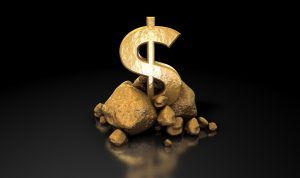This Week in Gold: Blockchain, Big Change and Insane
Posted onBlock chain
Investors continue to contrast the merits of investing in gold versus bitcoin. Most fall on one side of the debate and argue that one is better than the other. However, a recent development in the world of blockchain – the technology underpinning bitcoin – has unexpectedly joined these two assets.

Leaders in the gold and diamond market have teamed with IBM to harness the capabilities of blockchain. They intend to use the technology to track the provenance of the gold and diamonds in jewelry. IBM is powering the initiative, called TrustChain. This plan is a response to concerns of illegal and unethical practices surrounding gold and diamond mining in some regions. IBM’s Senior vice president remarked, “Consumers care deeply about the quality and source of the jewelry they purchase.” This concern is evidenced by the fact that “66 percent of consumers globally are willing to spend more to support sustainable brands,” she continued. This research comes from a Nielsen study which also found that “personal values are more important than personal benefits, such as cost or convenience.” Blockchain technology suits this task because it provides transparency via an open source ledger which updates in real time. It looks like gold and bitcoin are not so different after all.
Big Change
Sometimes gold just doesn’t know how to behave. Historically, gold and U.S. interest rates have been negatively correlated. In fact, this negative correlation increased sharply between 2013 and 2017. However, as of late, something has changed. As the World Gold Council remarks, “Gold continues to trend higher – increasing by 8.5% since the Federal Reserve rate hike in December 2017 – despite interest rates rising at an accelerated pace.” What’s going on here? Shouldn’t gold returns increase during periods of falling rate and vice versa? After all, investing in gold in such an environment wouldn’t come at the cost of foregoing U.S. Treasuries. However, the factors influencing gold prices are more numerous than just U.S. rates. Even in a rising rate environment, gold returns can increase as global demand for jewelry and technology increase. In fact, as the World Gold Council explains, the primary factors driving gold prices are, economic expansion, market uncertainty, opportunity cost of competing assets, and capital flows. This week Barron’s concluded that “Gold’s outlook looks rosy. The precious metal should benefit from late-cycle dynamics, which tend to favor real assets over stocks.”
Insane
Recently, the Managing Director of Sofies, a sustainability consulting and project management firm, remarked that just one ton of discarded cell phones contains as much gold as an entire mine. He continued to explain that “Gold is present in nature, and, on average, the concentration of gold is about 0.5 grams of gold for every one ton of material.” However, he continues, “in one ton of mobile phones, there is usually about 350 grams of gold.” The difference, and the opportunity, speaks for itself. Precious metals, like gold, can be reused in perpetuity, whereas other recyclables, like plastic, can only be reused a few times before their base properties breakdown. As the number of tech products in the American home increases, the stockpile of unused gold, copper, and iron and other metals also grows.







